- Walmart was one of the first major international brands to enter China, having opened its first store in 1996.
- Despite the early start, the brand has struggled to dominate in China as it has in the US, stalling out with a little over 400 stores.
- I visited a branch in Beijing recently. From the poorly designed store to the confused inventory of products, it was obvious why Walmart has struggled in the country.
Walmart was one of the first big international brands to enter China, drawn by the promise of big profits from the country’s exploding middle class, which is projected to grow to 550 million people by 2022.
Walmart opened its first store in China in 1996, in the city of Shenzhen, and has grown to 424 stores in the intervening years.
But despite this growth, it has stumbled mightily in its expansion efforts. By most accounts, Walmart failed to properly read Chinese consumers’ desires and cater its stores to the market. The resulting middling sales, combined with food safety scandals, rapid turnover of CEOs, and scuffles with the government, prevented the US retail giant from capitalizing on what many thought was a golden opportunity.
In recent years, Walmart has recovered some by investing in and partnering with JD.com, China's largest e-commerce retailer after Alibaba. That the retailer has placed its eggs in JD's e-commerce basket isn't a bad strategy, as Chinese consumers shift their spending to online.
By the most recent measures, e-commerce accounts for a whopping 21.4% of total retail in China. By comparison, the US is hovering around 12%. In recent years, Walmart has built out a robust online grocery business.
During a recent visit to China, I decided to check out a Walmart in Beijing. The store - which was in many ways nothing like its US counterpart - provided a clear indication why the retailer's China strategy has been failing for so long.
Here's what it was like.
I went to a Walmart in Beijing's Chaoyang district, a popular shopping area in the city. It's not far from the swanky Sanlitun area, as well as many foreign embassies. But the entrance to Walmart was a bit dingy.

Many of the pictures I've seen of Walmarts in China show products like pigs' heads and crocodiles. I was surprised to hear that Walmart has been criticized for not catering to the China market.

But once I got inside, the retailer's mistakes (at this location at least) became apparent. The Walmart was located in the basement of a dingy shopping mall

It was hardly inviting. There were lockers out front for shoppers to lock up valuables before they go in.

When you walk in, there is an attendant shouting that day's promotions, a not unusual occurrence in Chinese stores. From the first few steps in the store, it feels like a low-quality retailer. The ceilings are low, the aisles tight, and the lighting low-quality.

It was strange to see a Walmart in China look in worse shape than a typical store in the US. Chinese consumers generally seek out foreign brands due to a perception of higher quality. There was a large selection of high-end foreign skin products.

Source: Reuters
Successful American chains in China like KFC and McDonald's have capitalized on the perception of higher quality. Those restaurants, from the locations I saw, were bright, clean, and modern. So much so that they seemed to be popular hangouts for families and students in the neighborhoods.

Walmart, on the other hand, was the opposite. Its prices were slightly higher than other supermarkets I've been to in China, but its environment didn't reflect that. It did, however, have this large snack section where you pay by the pound.

Walmart has notoriously struggled to adapt its inventory from city to city in China, where consumer needs vary greatly. In the case of this store, at least, it seemed to have made some improvement. Just near the door was a selection of pollution masks, a nod to Beijing's persistent smog.

Source: Fortune
There were only three aisles of home goods, like these hot plates (many Beijing apartments lack a stove). Overall, the store seemed confused. Aisles of high-end cosmetics were adjacent to discount toilet paper and tissues.
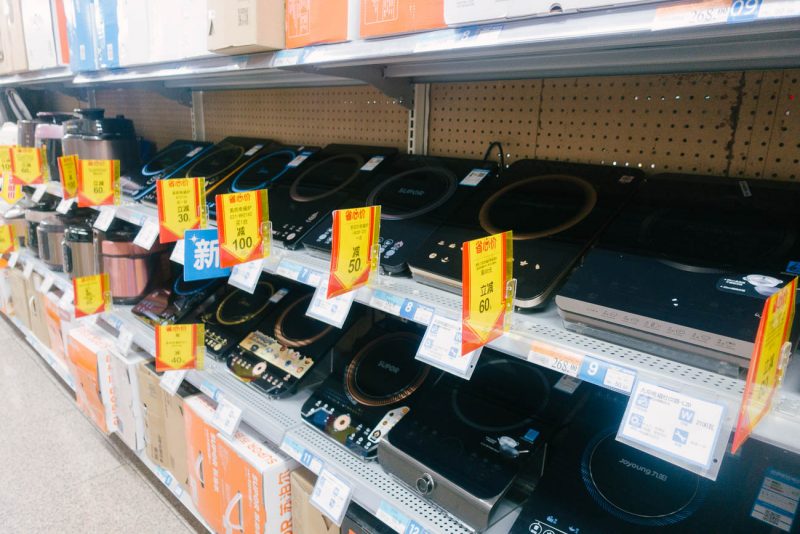
There were also tons of rice-cookers. The small amount of home goods is no doubt due to an acknowledgement that Chinese consumers tend to buy such products online and shop in person for fresh produce and meat. Only 2% of fresh food was bought online in China, compared to 21% of overall retail.

Source: Bloomberg News
But, even so, the vast majority of the products were packaged goods that could easily be purchased online like this dried seaweed.
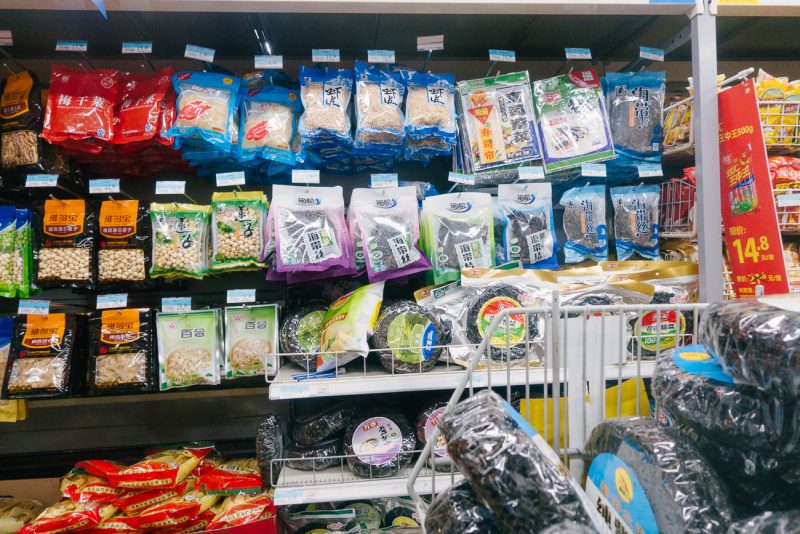
And dried mushrooms...

There was an entire aisle for different types of salts and sugars (seaweed salt, rock salt, rock sugar, etc).

And entire aisles for other staples like soy sauces and oils.

But the store couldn't seem to decide whether it wanted to be a discount or luxury retailer. There was an aisle for very high-end liquor, locked behind a glass case. China's highest end liquor, Maotai, which costs upwards of $200 a bottle, was in stock.

Source: Jing Daily
The section that I expected to be the biggest — fresh meat and produce — was stuck in the back of the store, and no larger than that of a supermarket in the US. Still, it did sell chicken feet, a Chinese staple.

As well as various cuts of pig, including leg, ribs, and trotters. Behind the counter was a butcher's station, so I assume it had been butchered that day.

I had read a lot about Walmart China's live seafood tanks, but they were a disappointment. The store I visited had a few, mostly empty tanks with not many fish in them.

There were tanks of frogs and turtles.
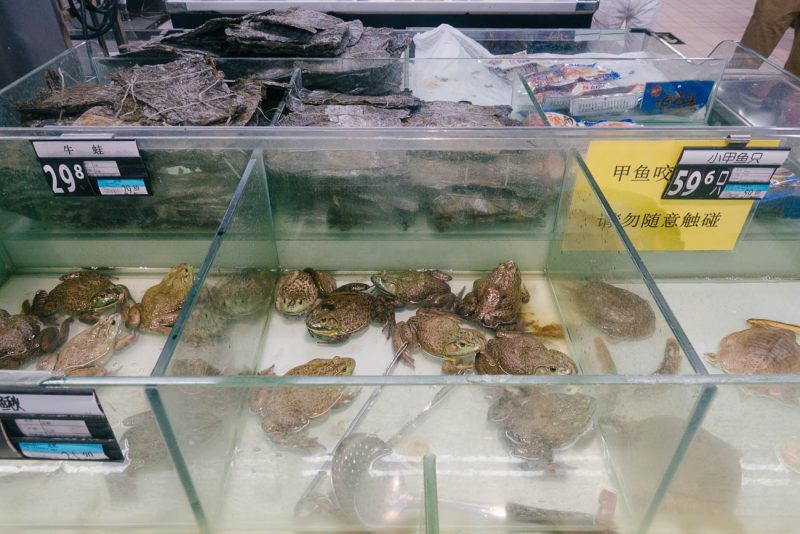
And a bunch of other shellfish. But for a hypermarket a couple of hours before the after-work rush, it looks positively barren.

It was a stark contrast to a recent visit I took to Alibaba and JD.com's new grocery store concepts, where an entire room was dedicated to teeming tanks due to Chinese consumers' desire for fresh, well-sourced seafood. This is what it looked like at Hema Xiansheng, Alibaba's new grocery store.
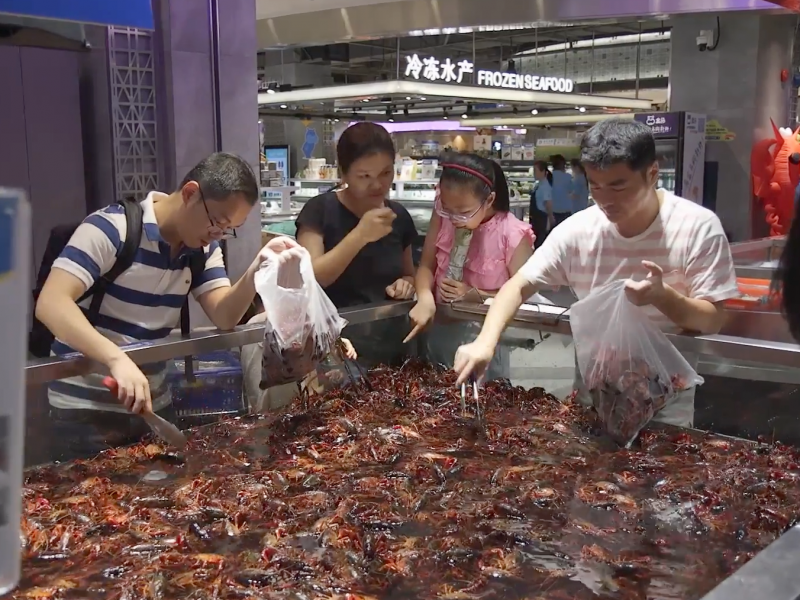
Walmart did have a very large section for eggs. Chinese consumers don't just eat chicken eggs. Duck eggs, quail eggs, and preserved eggs are all popular.
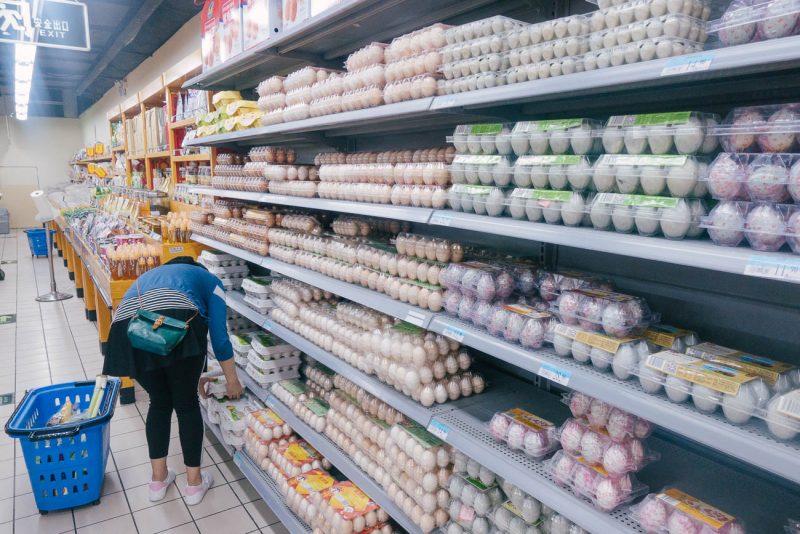
The fresh produce seemed to be the only section that hit the mark. The fruit looked good, but it was much pricier than the abundant fruit stands on the street and looked only marginally better.

Chinese consumers tend to be fanatical about the quality of their fruit, so there are numerous fruit-tasting stations in the produce section. But it looked like it had been a while since they'd been replenished.

There's a station behind the produce for you to get your fruit and veggies weighed before bringing them to checkout. If you forget, you'll have to leave the line and head back (this happened to me).

In the middle of the produce section, there is a large section for high-end tea. Like the liquor and foreign face products, it seems to come out of nowhere. While all three are certainly products Chinese consumers purchase, they send mixed messages.

There was a hot food section that sold duck wings, among a number of other options. The duck wings were dry and overcooked and the rest of the food looked unappetizing. With the abundance of tasty, cheap, and freshly-cooked food all over Beijing, I wouldn't come to Walmart for a quick meal.

Though it did have a jian biang-station. Jian biang, a kind of Chinese crepe loaded with toppings, is a Beijing street food specialty.

The checkout experience wasn't much better. The lines were cramped and slow-moving. It seemed ancient next to the rapid-fire mobile payments-empowered checkouts I've flown through in the rest of China.

Overall, it seemed little surprise that Walmart has struggled so much in China. The store I visited had a confused inventory of mid-range groceries, with a few pockets of high-end products like liquor and tea in a discount setting. The fresh food, supposedly the highlight for Chinese consumers, hardly lived up to expectations.

At least in Walmart's physical store, it seemed like the brand was struggling to see what value it could offer Chinese consumers. Walmart made its fortune in the US with selling discount products to America's middle class, but China is already flooded with cramped stores selling cheap products.
What Chinese consumers have less access to is transparently-sourced fresh foods and high-quality home goods in a clean, modern experience. China's top online retailers, Alibaba and JD.com, have clearly recognized this need and set about offering it through the Hema Xiansheng and 7Fresh grocery store chains respectively. Both e-retailers have made plans to open hundreds of those stores in the coming years.
If Walmart was smart, it would revamp its physical locations with an eye on how Alibaba and JD are appealing to China's savvy and urbanized middle class. Walmart may have taken its first step towards doing so earlier this month, after it opened a small, high-tech supermarket in Shenzhen in partnership with JD.com.
Walmart messed up golden opportunities in China when it first entered the market in the '90s and then again several years ago when it bet on the wrong e-commerce retailer. Time will only tell if the retailer has learned from its mistakes.

